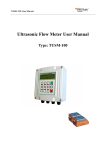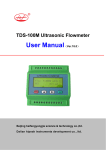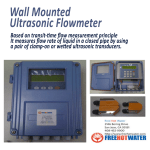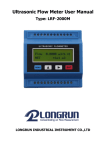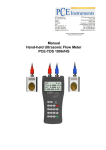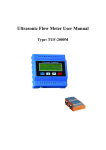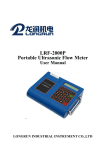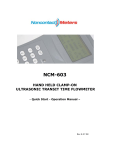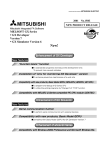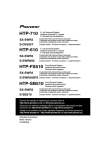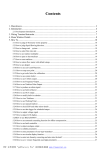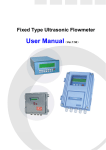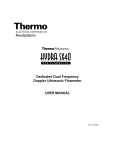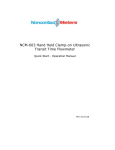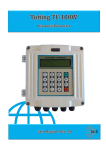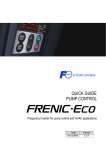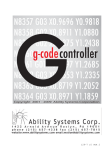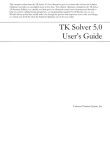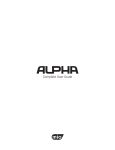Download Ultrasonic Flowmeter: Installation and User Manual
Transcript
AMI Ultrasonic Flowmeter: Installation and User Manual Version 1.1 AMI Table of Contents Section 1: Getting Started ..................................................................................................................3 1.1 Things to know ....................................................................................................................3 1.2 Transducer site requirements...............................................................................................3 1.3 Using the keys .....................................................................................................................5 Section 2: Mounting the Transducers..................................................................................................5 2.1 Choose mounting method ....................................................................................................5 2.2 Preparing pipe surface .........................................................................................................5 2.3 Preparing the transducer......................................................................................................5 V-Method Installation..................................................................................................................6 Z-Method Installation ..................................................................................................................6 W- Method Installation................................................................................................................6 Section 3: Necessary Measurements...................................................................................................7 Section 4: Fine Tuning and Troubleshooting........................................................................................8 4.1 Setting Your Zero Point ........................................................................................................8 4.2 Fine Tuning..........................................................................................................................8 4.3 Manual Totalizer Reset.........................................................................................................8 4.4 Troubleshooting ..................................................................................................................9 Appendix A: Menu Screens...............................................................................................................10 Ultrasonic Flowmeter: Installation and User Manual Version 1.1 Page 2 Kit Includes: 1 – AMI Enclosure 1 – Ultrasonic Flowmeter 2 – Transducers (4’ cable) 2 – 4” Clamps 2 – 6” Clamps (Join together w/4” if using on larger pipe) 1 – Tube synthetic grease Section 1: Getting Started Please read through this entire section before installing your Ultrasonic Flowmeter for the first time. 1.1 Things to know All setup parameter data is stored temporarily in RAM. To make changes permanent, you must save your changes in menu Screen 26. Any changes not stored by this method will be lost upon device reboot. To obtain the most accurate readings, device must first be calibrated with zero flow through the pipe (zero point). This reading can be set as the zero point in Menu Screen 42 (M42). The size of the pipe will determine the best transducer mounting method. Refer to section 3 for best mounting methods. It is recommended to fill out the form in section 2 prior to bringing the unit to the field to be installed. You can also preset the information into the device prior to installing to save time. All setup parameter data is stored temporarily in RAM. To make changes permanent, you must save your changes in menu Screen 26. Any changes not stored by this method will be lost upon device reboot. 1.2 Transducer site requirements The following conditions must be met to have valid and usable data from the Ultrasonic Flowmeter. If any or all of the conditions do not meet the requirements, the meter will not function properly. Pipe must be full of liquids at time of reading No heavy corrosion or deposition inside of pipe Must be in safe and secure location As a general rule, the pipe must not be shorter than 15xdiameter. Insufficient straight pipe length will degrade the accuracy. The mounting site for the transducers should be 10D upstream and 5D downstream If there are flow disturbing parts (such as pumps, valves, etc) upstream, the straight pipe length should be increased Ultrasonic Flowmeter: Installation and User Manual Version 1.1 Page 3 Ultrasonic Flowmeter: Installation and User Manual Version 1.1 Page 4 1.3 Using the keys Menu – used for entering into various menu windows Page up – used for advancing menu windows, and for adding digits Page down – use to move cursor into next digit position Enter – use to enter selection Example – to enter menu window 26, the user would press: x1 x2 x1 x6 x1 Section 2: Mounting the Transducers The transducers can be attached using three different methods: 2.1 Choose mounting method The size of the pipe will determine the best method to mount your transducers. Generally, for pipes over 4” you want to use the Z-Method 2.2 Preparing pipe surface The pipe surface where the transducers will be mounted should be clean and free from any rust, paint and moisture. A dry, clean surface will ensure a good acoustic bond between transducers and the pipe. 2.3 Preparing the transducer Clean and dry the transducer contact surface. Apply synthetic grease on transducer where it will contact the pipe. Do not apply more grease than necessary, especially on smaller pipes. If installing on a horizontal pipe, the transducers should be mounted on the sides of the pipe to minimize air bubbles interfering with the signal quality! Ultrasonic Flowmeter: Installation and User Manual Version 1.1 Page 5 V-Method Installation The V-Method is most commonly used for pipe diameters ranging from ¾” to 8” and is also referred to as Reflective Mode. Z-Method Installation The Z-Method can be used for pipe sized ranging from 4” to 23 ½”. We recommend using the Z method when the pipe is 4” or greater. W- Method Installation The W-Method is most widely used on smaller pipes, ½” to 1 ¾” in size. Ultrasonic Flowmeter: Installation and User Manual Version 1.1 Page 6 Section 3: Necessary Measurements The following sheet contains the basic information necessary to setup your Ultrasonic Flowmeter. It is recommended the user fills out completely as much information ahead of time as possible. You can either fill out this form, or enter the necessary data directly into the flow meter. Parameter Menu Screen Note Pipe Outer Diameter 11 Pipe Wall Thickness 12 Pipe Inner Diameter 13 Pipe Materials* 14 Liner Material and its sound speed and thickness (if any) 16 Liquid type* 20 Transducer type connected to flow meter 23 Transducer mounting method (See section 2) 24 Transducer spacing (Will be displayed in screen 24) 25 Measurements in Units 30 Set to English Flow Rate Units 31 Set to g/m or GPM Default Settings† 26 1. Solidify Settings View Data 00 To obtain flow readings Clamp on L2 * Standard pipe materials and standard liquids refer to those with the sound parameters that have already been programmed into the flow meter software. Non standard pipe materials and non standard liquids will need the sound speed configured. † You must store the settings when completed or the unit will reset to default settings upon startup Ultrasonic Flowmeter: Installation and User Manual Version 1.1 Page 7 Section 4: Fine Tuning and Troubleshooting 4.1 Setting Your Zero Point If possible, stop all flow running through the pipe while maintaining a pipe full of liquid. Parameter Set Zero 4.2 Menu Screen 42 Note Zero calibration/Zero Point Setup Fine Tuning For the flow meter readings to be considered accurate, you must confirm the data in two menu screens. Parameter Menu Screen Signal Strength + Quality 90 Transit Time Ratio Tips: 91 Note Poor <60 Optimal 60-99 Poor >90 100% +/-3% If necessary, move transducers closer to, or further from, each other to increase or decrease the values in screen 91 Make sure the transducer mounting area on the pipe is coating free and smooth. 4.3 Manual Totalizer Reset Should you want to reset the totalizer values you can do so in Menu 37. You can use a calibration totalizer on Menu 38. Parameter Totalizer Reset Manual Totalizer Ultrasonic Flowmeter: Installation and User Manual Version 1.1 Menu Screen 37 38 Note Reset All Use for manual calibration of flow Page 8 4.4 Troubleshooting If you are unable to get a flow reading, or if your values in screens 90 and 91 are not within their thresholds: Is the pipe too old? Too much corrosion? Too many air bubbles? Is the pipe full? Are your parameters correct? Are the transducers located too close to the pump, valve or elbow in the pipe? Is the transducer spacing correct (menu screen 24) Ultrasonic Flowmeter: Installation and User Manual Version 1.1 Page 9 Appendix A: Menu Screens Menu window No. Function Display flow rate and NET totalizer M00 If the net totalizer is turned off, the net totalizer value shown on the screen is the value prior to its turn off Select all totalizer unit in menu M31 M01 Display flow rate, velocity Display date time and POS(positive) totalizer M02 If the positive totalizer is turned off, the positive totalizer value shown on the screen is the value prior to its turn off Display flow rate and NEG(negative) totalizer M03 If the negative totalizer is turned off, the negative totalizer value shown on the screen is the value prior to its turn off M04 Display date and time, flow rate. The date and time setting method is found in MENU60 M05 Display energy rate(instantaneous Caloric)and total energy (Caloric) M06 Display temperatures, inlet T1, outlet T2 M07 Display analog inputs, AI3/AI4, current value and its corresponding temperature or pressure or liquid level value Display all the detailed error codes M08 Display working condition and system error codes. ‘R’ stands for normal, others refer to Chapter 8 for details. M09 Display today’s total NET flow M10 Window for entering the outer perimeter of the pipe. If pipe outer diameter is known, skip this menu and go to Menu 11 to enter the outer diameter Ultrasonic Flowmeter: Installation and User Manual Version 1.1 Page 10 Window for entering the outer diameter of the pipe. Valid range:0 to 18000mm. M11 Note: you just need to enter either the outer diameter in M11 or the peripheral in M10 Window for entering pipe wall thickness M12 You may skip the menu and enter inner diameter in M13 instead. Window for entering the inner diameter of the pipe M13 If pipe outer diameter and wall thickness are enter correctly, the inner diameter will be calculated automatically, thus no need to change anything in the window Window for selecting pipe material Standard pipe materials (no need to enter material sound speed ) include: M14 (0) carbon steel (1) stainless steel (2) cast iron (3) ductile iron (4) copper (6) aluminum ,(7) asbestos (8) fiberglass (5) PVC (9) other( need to enter material sound speed in M15) M15 Window for entering the pipe material speed, only for non-standard pipe materials Window for selecting the liner material, select none for pipes without any liner. Standard liner materials(no need to enter the liner sound speed) include: M16 (1) Tar Epoxy (2) Rubber (3) Mortar (4) Polypropylene (5) Polystryol (6)Polystyrene (7) Polyester (8) Polyethylene (9) Ebonite (10) Teflon (11) Other (need to enter liner sound speed in M17) M17 Window for entering the non-standard liner material speed. M18 Window for entering the liner thickness, if there is a liner M19 Window for entering the ABS thickness of the inside wall of the pipe Window for selecting fluid type M20 For standard liquids(no need to enter fluid sound speed) include: (0) Water (1) Sea Water (2) Kerosene Ultrasonic Flowmeter: Installation and User Manual Version 1.1 Page 11 (3) Gasoline (4) Fuel oil (5) Crude Oil (6) Propane at -45C (7) Butane at 0C (8)Other liquids(need to enter sound speed in M21 and viscosity in M22) (9) Diesel Oil (10)Caster Oil (11)Peanut Oil (12) #90 Gasoline (13) #93 Gasoline (14) Alcohol (15) Hot water at 125C M21 Window for entering the sound speed of non- standard liquid, used only when option item 8 ‘Other’ is selected in M20 M22 Window for entering the viscosity of the non-standard liquids, used only when option item 8 ‘Other’ is selected in M20 Window for selecting transducer type, There are 22 types as following M23 0. Standard M 1. 2. Insertion Type C Standard S 3. User Type 4. 5. Standard B Insertion Type B(45) 6. Standrad L 7. 8. JH-Polysonics Standard-HS 9. Standard-HM 10. Standard-M1 (middle M1 transducer) 11. Standard-S1 (small S1 transducer) 12. Standard-L1 (large L1 transducer) 13. PI-Type 14. FS410 15. FS510 16. Clamp-on TM-1 17. Insertion TC-1 18. Calmp-on TS-1 19. Reserved 20. Clamp-on TL-1 Ultrasonic Flowmeter: Installation and User Manual Version 1.1 Page 12 21. Insertion TLC-2 If the user-type-transducer is selected, you need enter additional 4 user-type-wedge parameters that describe the user transducers. If the PI-type transducer is selected, you need enter additional 4 PI-type transducer parameters that describe the PI-type transducers Window for selecting the transducer mounting methods M24 Four methods can be selected: (0) V-method (1) Z-method (2) N-method (3) W-method M25 Display the transducer mounting spacing or distance M26 (1) A switch for the parameters in flash memory will be loaded when power is turned on. The default option is that the parameters will be loaded. If this switch is not turned on, the system will try to use the parameters in the system RAM, if these parameters are ok, otherwise the system will load the parameters in flash memory (2) Function to store the current parameters into the flash memory, so that these parameters will be solidified and will be loaded as the default parameters every time when power is turned on. Entry to store to or restore from the internal Flash memory, as many as 9 different pipe parameter configurations M27 M28 To save or load the current setup parameter, use the going up or going down keys to change the address number, press ‘ENT’ key, and use going down or going up keys to select to save to or load from the memory. Entry to determine whether or not to hold (or to keep) the last good value when poor signal condition occurs. YES is the default setup. Entry to setup empty signal threshold. When the signal is less than this threshold, the pipe is regarded as empty pipe, and the flow meter will not totalize flow. M29 This is based on the fact that, for most occasions, when pipe is empty, the transducer would still receive signal, just smaller than normal, As a result, The flow meter would show normal operation, which is not correct. Make sure that the entered value must be less than the normal signal strength. When much noisy signals are received, to make sure the flow meter will not incorrectly Ultrasonic Flowmeter: Installation and User Manual Version 1.1 Page 13 totalize flow, there is also a ‘Q’ threshold should be entered in M.5 M30 Window for selecting unit system. The conversion English to Metric or vice versa will not affect the unit for totalizers. Window for selecting flow rate unit system. Flow rate can be in 0. Cubic meter short for (m3) M31 1. Liter 2. USA gallon (l) (gal) 3. Imperial Gallon (igl) 4. Million USA gallon 5. Cubic feet (mgl) (cf) 6. USA liquid barrel (bal) 7. Oil barrel (ob) The flow unit in terms of time can be per day, per hour, per minute or per second. So there are 32 different flow rate units in total for selection. M32 Window for selecting the totalizers unit. Available units are the same as those in M31 Window for setting the totalizer multiplying factor M33 The multiplying factor ranges from 0.001 to 10000. Factory default is 1 M34 Turn on or turn off the NET totalizer M35 Turn on or turn off the POS (positive) totalizer M36 Turn on or turn off the NEG(negative) totalizer (1) Totalizer reset M37 M38 (2) Restore the factory default settings parameters. Press the dot key followed by the backspace key. Attention, It is recommended to make note on the parameters before doing the restoration Manual totalizer used for easier calibration. Press a key to start and press a key to stop the manual totalizer. Ultrasonic Flowmeter: Installation and User Manual Version 1.1 Page 14 Interface Language selection. M39 M40 The selection could also be changed automatically by the system, if English LCD display is used as the display device. Flow rate damper for a stable value. The damping parameter ranges form 0 to 999 seconds. 0 means there is no damping. Factory default is 10 seconds M41 Low flow rate (or zero flow rate) cut-off to avoid invalid accumulation. M42 Zero calibration/Zero point setup. Make sure the liquid in the pipe is not running while doing the setup. M43 Clear the zero point value, and restore the solidified zero point value. M44 Set up a flow bias. Generally this value should be 0. M45 Flow rate scale factor. The default value is ‘1’. Keep this value as ‘1’, when no calibration has been made. Networks address identification number. Any integer can be entered except 13(0DH, carriage return), 10 (0AH, line feeding), 42 (2AH), 38, 65535. M46 Every set of the instrument in a network environment should have a unique IDN. Please refer to the chapter for communication. System locker to avoid modification of the system parameters. M47 M48 If password is forgotten, you could send a command ‘LOCK0’ to the serial input to unlock. Or you can write 0 to REGISTER49-50 under MODBUS protocol. Entry to linearity correcting data inputs. By using of this function, the non-linearity of flow meter will be corrected. Correcting data shall be obtained by careful calibration. Displays the input contents for the serial port. M49 M50 By checking the displays, you can know if the communication is ok. Switches for the built-in data logger. There are as many as 22 different items can be chosen. To turn this function, select ‘YES’ the system will ask for selecting the items. Ultrasonic Flowmeter: Installation and User Manual Version 1.1 Page 15 There are 22 items available. Turn on all those items you want to output M51 Window to setup the time of scheduled output function (data logger, or Thermo-printer). This includes start time, time interval and how many times of output. When a number great than 8000 entered for the times of output, It means the output will be keeping always. The minimum time interval is 1 second and the maximum is 24 hours. Data logging direction control. M52 (1) If ‘Send to RS485’ is selected, all the data produced by the data logger will be transmitted out through the RS-232/RS485 interface (2) If ‘To the internal serial BUS is selected, the data will be transmitted to the internal serial bus which allows a thermal printer, or a 4-20mA analog output module, to be connected to it. M53 Display analog inputs, AI5, current value and its corresponding temperature or pressure or liquid level value. M54 Pulse width setup for the OCT (OCT1) output. Minimum is 6 mS, maximum is 1000 mS Select analog output (4-20mA current loop, or CL) mode. Available options: (0) 4-20mA output mode (setup the output range from 4-20mA) (1) 0-20mA output mode (setup the output range from 4-20mA, This mode can only be used with Version-15 flow meter) (2) Serial port controls 0-20mA M55 (3) 4-20mA corresponding fluid sound speed (4) 20-4-20mA mode (5) 0-4-20mA mode (can only be used with Version-15 flow meter) (6)20-0-20mA mode(can only be used with Version-15 flow meter) (7) 4-20mA corresponding flow velocity (8)4-20mA corresponding heat flow rate M56 4mA or 0mA output value, Set the value which corresponds to 4mA or 0mA output current (4mA or 0mA is Ultrasonic Flowmeter: Installation and User Manual Version 1.1 Page 16 determined by the setting in M55) 20mA output value, M57 Set the value which corresponds to 20mA output current Current loop verification M58 Check if the current loop is calibrated correctly. M59 Display the present output current of current loop circuit. M60 Setup system date and time. Press ENT for modification. Use the dot key to skip the digits that need no modification. M61 Display Version information and Electronic Serial Number (ESN) that is unique for each flow meter. The users may employ the ESN for instrumentation management RS-232/RS485 setup. All the devices connected with flow meter should have matched serial configuration. M62 The following parameters can be configured: Baud rate (300 to 19200 bps), parity, data bits (always is 8), stop bits Select communication protocol. M63 Factory default is ‘MODBUS ASCII. this is a mode for MODBUS-ASCII, Meter-BUS, Fuji Extended Protocol If you are going using MODBUS-RTU you have to select ‘MODBUS_RTU’. AI3 value range. M64 Used to enter temperature/pressure values that are corresponding to 4mA and 20mA input current. The display values have no unit, so that they can present any physical parameter. AI4 value range. M65 Used to enter temperature/pressure values that are corresponding to 4mA and 20mA input current. Ultrasonic Flowmeter: Installation and User Manual Version 1.1 Page 17 AI5 value range. M66 Used to enter temperature/pressure values that are corresponding to 4mA and 20mA input current. Windows to setup the frequency range (lower and upper limit) for the frequency output function. Valid range is 0Hz-9999Hz. Factory default value is 0-1000 Hz. M67 For Version-12, Version-13, Version-14 flow meters, you need a hardware module, which shall be plugged to the Serial Expanding Bus, for the frequency output function. Please remember to order the module if you need frequency output function. For Version-15 flow meter, you need to indicate on your orders that you need the frequency function; Otherwise you will get a flow meter which has no frequency output circuits. M68 Window to setup the minimum flow rate value which corresponds to the lower frequency limit of the frequency output. M69 Windows to setup the maximum flow Rate value that corresponds to the upper frequency limit of the frequency output. M70 LCD display backlight control. The entered value indicates how many seconds the backlight will be on with every key pressing. If the enter value is great than 50000 seconds, It means that the backlight will always keeping on. M71 LCD contrast control. The LCD will become darker or brighter when a value is entered. M72 Working timer. It can be cleared by pressing ENT key, and then select YES. M73 Window to setup the lower limit of flow rate for Alarm#1. When the flow rate is below the set value, Alarm#1 equals ‘on’ Window to setup the upper limit of flow rate for Alarm#1. When the flow rate is above the set value, Alarm#1 equals ‘on’ M74 M75 There are two alarms in the flow meter, and every alarm can be pointed to alarm output devices such as the BUZZER or OCT output or RELAY output. For example, if you want the Alarm#1 is to output by the OCT circuit, you need to set M78 at selection item 6. Window to setup the lower limit of flow rate for Alarm#2. Ultrasonic Flowmeter: Installation and User Manual Version 1.1 Page 18 M76 Window to setup the upper limit of flow rate for Alarm#2. Buzzer setup. If a proper input source is selected, the buzzer will beep when the trigger event occurs. The available trigger sources are: 0. No Signal 1. Poor Signal 2. Not Ready (No*R) M77 3. Reverse Flow 4. AO Over 100% 5. FO Over 120% 6. Alarm #1 7. Reverse Alarm #2 8. Batch Control 9. POS Int Pulse 11.NET Int Pulse 12.Energy POS Pulse 13.Energy NEG Pulse 10.NEG Int Pulse 14.Energy NET Pulse 15.MediaVel=>Thresh 16.MediaVelo<Thresh 17.ON/OFF viaRS232 18.Daily Timer (M51) 19.Timed alarm #1 20. Timed alarm #2 21.Batch Totalizer Full 22. M51 Timer 23. Key Stroking ON 24.Disable BEEPER OCT (Open Collect Transistor Output)/OCT1 setup By selecting a proper input source, the OCT circuit will close when the trigger event occurs. The available trigger sources are: 0. No Signal 1. Poor Signal 2. Not Ready(No*R) 3. Reverse Flow 5. FO Over 120% 6. Alarm #1 M78 8. Batch Control 9. POS Int Pulse 4. AO Over 100% 7. Reverse Alarm #2 10.NEG Int Pulse 11.NET Int Pulse 12.Energy POS Pulse 13.Energy NEG Pulse 14.Energy NET Pulse 15.MediaVel=>Thresh 16.MediaVelo<Thresh 17.ON/OFF viaRS232 18. Daily Timer (M51) 19.Timed alarm #1 20. Timed alarm #2 21.Batch Totalizer Full 22. Periodically M51 Timer 23. Oct Not Using Ultrasonic Flowmeter: Installation and User Manual Version 1.1 Page 19 The OCT circuit does not source voltage at its output. It must be connected with an external power and pull-up resistant for some occasions. When the OCT circuit is close, it will draw current. The maximum current shall not be over 100mA. Attention: the maximum voltage applied to OCT can not be over 80 volts. Relay or OCT2 setup By selecting a proper input source, the RELAY will close when the trigger event occurs The available trigger sources are: 0. No Signal 1. Poor Signal 2. Not Ready(No*R) 3. Reverse Flow M79 4. AO Over 100% 5. FO Over 120% 6. Alarm #1 7. Reverse Alarm #2 8. Batch Control 9. POS Int Pulse 10.NEG Int Pulse 11.NET Int Pulse 12.Energy POS Pulse 13.Energy NEG Pulse 14.Energy NET Pulse 15.MediaVel=>Thresh 16.MediaVelo<Thresh 17.ON/OFF viaRS232 18. Timer (M51 Daily) 19.Timed alarm #1 20. Timed alarm #2 21.Batch Totalizer Full 22. Periodically M51 Timer 23. Disable Relay The RELAY is of SPST(Single pole, single throw) type. It is rated for 110VAC max and have a current rating of 0.5A resistive load. It highly recommended that a salve relay to be utilized whenever a large resistive load or inductive load is to be controlled. Note. In order to make the user interface compatible with the former version7, the name RELAY was used other than OCT2, but in fact it is an OCT output. Window for selecting the trig signal for the built-in batch controller. Available trig sources: M80 0. Key input (press ENT key to start the batch controller) 1. Serial port Ultrasonic Flowmeter: Installation and User Manual Version 1.1 Page 20 2. AI3 rising edge (when AI3 receives 2mA or more current) 3. AI3 falling edge 4. AI4 rising edge (when AI3 stop receiving 2mA or more current) (when AI3 receives 2mA or more current) 5. AI4 falling edge (when AI3 stop receiving 2mA or more current) 6. AI5 rising edge (when AI3 receives 2mA or more current) 7. AI5 falling edge (when AI3 stop receiving 2mA or more current) 8.Timer periodically (define the start time and interval time in M51) 9.Timer daily (define the start time and interval time in M51) For the input analog current signal, 0 mA indicates “0”, 4mA or more indicates ‘1’. By selecting item #8, the batch totalizer can be started periodically by the internal timer located at Menu51. When the batch totalizer is full, a signal which indicate the batch is full can be direct to either the OCT or the RELAY terminals to stop the pump or other devices. By selecting item #9, the batch totalizer could act as totalizer which runs for only a period of the day so that a alarm signal could be produced if the total flow during that time period is over a certain amount of. For example, if you want a alarm signal which stand for the total flow is over 100 cubic meters during the pe riod of every day from 20:00 to 06:00, setups is like M51 start time =20:00:00 M51 interval =10:00:00 M51 log times =9999 (means always) M80 select item #9 M81 input 100 (Unit is defined in M30,M31,M32) The built-in batch controller Set the flow batch value(dose) M81 The internal output of the batch controller can be directed either to the OCT or the RELAY output circuits. M81 and M80 should be used together to configure the batch controller. Ultrasonic Flowmeter: Installation and User Manual Version 1.1 Page 21 Note: Because the measuring period is 500mS, the flow for every dos should be keeping at 60 seconds long to get a 1% dose accuracy. View the daily, monthly and yearly flow totalizer and thermal energy totalizer value. M82 The totalizer values and errors for the last 64 days, 32 last 32 months and last 2 years are stored in the RAM memory, To view them, use the ‘ENT’ and ‘UP’ ‘Down’ keys. Automatic Amending Function for automatic offline compensation. Select ‘YES’ to enable this function, select ‘NO’ to disable it. M83 When the function is enabled, The flow meter will estimate the average flow uncounted (or ‘lost’) during the offline session and add the result to the totalizer. The estimation of the uncounted flow is made by computing the product of the offline time period and the average flow rate, which is the average of the flow rate before going offline and the one after going on line. Set the thermal energy unit: M84 0. GJ 1. KC 2.KWh 3. BTU Select temperature sources M85 0. from T1,T2 (factory default) 1. from AI3,AI4 Select the Specific Heat Value. M86 Factory default is ‘GB’. Under this setting, the flow meter will calculate the enthalpy of water based on the international standard. If the fluid is other than water, you should select option ‘1. Fixed Specific Heat’, and enter the specific heat value of the fluid. M87 Turn on or turn off the Energy totalizer. Select thermal energy totalizer multiplying factor. M88 M89 Factory default is ‘1’. 1. Display the temperature difference Ultrasonic Flowmeter: Installation and User Manual Version 1.1 Page 22 2. Window for entering the lowest temperature difference. Display signal strengths S (one for upstream and one for downstream), and signal quality Q value. M90 Signal strength is presented by 00.0 to 99.9, the bigger the value, the bigger the signal strength will be, and more reliable readings will be made. Q value is presented by 00 to 99, the bigger the better. It should at least be great than 50 for normal operations. M91 Displays the Time Ratio between the Measured Total Transit Time and the Calculated time. If the pipe parameters are entered correctly and the transducers are properly installed, the ratio value should be in the range of 100±3%. Otherwise the entered parameters and the transducer installation should be checked. M92 Displays the estimated fluid sound velocity. If this value has an obvious difference with the actual fluid sound speed, pipe parameters entered and the transducer installation should be checked again. M93 Displays total transit time and delta time(transit time difference) M94 Displays the Reynolds number and the pipe factor used by the flow rate measurement program. Pipe factor is calculated based on the ratio of the line-average velocity and the cross-section average velocity. (1) Display the positive and negative energy totalizers M95 (2) Upon entering this window, the circular display function will be started automatically. The following windows will be displayed one by one, each window will stay for 8 seconds: M95>>M00>>M01>>M02>>M02>> M03>>M04>>M05>>M06>>M07>>M08>>M90>>M91>>M92>> M93>> M94>>M95. This function allows the user to visit all the important information without any manual action. To stop this function, simply press a key. Or switch to a window other than M95. M96 This is not a window but a command for the thermal printer to advance 5 lines of paper. This is not a window but a command to print the pipe parameters. M97 By default, the produced data will be directed to the internal serial bus (thermal printer). You can also direct those data to the serial communication port. Ultrasonic Flowmeter: Installation and User Manual Version 1.1 Page 23 This is not a window but a command to print the diagnostic information. M98 By default, the produced data will be directed to the internal serial bus (thermal printer). You can also direct those data to the serial communication port. This is not a window but a command to copy the current display window. By default, the produced data will be directed to the internal serial bus (thermal printer). You can also direct those data to the serial communication port. M99 M+0 M+1 By use of the window copying function, you can hardcopy very window displaying manually by switching windows, or you can obtain the window displaying data by communication. Browse the 32 recorded instrument power-on and power-off date and time with the flow rate at the time of power on and off Displays the total working time of the flow meter. When the backup battery is removed, the total working time will be reset to zero. M+2 Displays the last power-off date and time M+3 Displays the last power-off flow rate M+4 Displays how many times of has been powered on and powered off. A scientific calculator for the convenience of field working. All the values are in single accuracy. M+5 The calculator can be used while the flow meter is conducting flow measurement. Water density and PT100 temperature can also be found in this function. Set fluid sound speed threshold M+6 Whenever the estimated sound speed (displayed in M92) exceeds this threshold, an alarms signal will be generated and can transmitted to BUZZER or OCT or RELAY. This function can used to produce an alarm or output when fluid material changes. M+7 Displays total flow for this month(only for the time past) M+8 Displays total flow for this year(only for the time past) Ultrasonic Flowmeter: Installation and User Manual Version 1.1 Page 24 M+9 Display the not-working total time in seconds. The total failure timer will also include the time when power off, if the back-up battery is applied. M.2 Entry to solidify the zero point. Password protected. Setup the Q value threshold. M.5 If the present Q is below this threshold, flow rate will be set to 0. This function is useful when flow meter is installed in noisy environment or on airy pipes. M.8 The maximum flow rates for today and this month. M.9 Serial port tester with CMM command output for very second. M-0 Entry to hardware adjusting windows only for the manufacturer M-1 4-20mA output adjustment M-2 4mA calibration for AI3 input M-3 20mA calibration for AI3 input M-4 4mA calibration for AI4 input M-5 20mA calibration for AI4 input M-6 4mA calibration for AI5 input M-7 20mA calibration for AI5 input M-8 Lower Temperature Zero setup for the PT100 M-9 Higher Temperature Zero setup for the PT100 M-A Temperature Calibration at 50℃ M-B Temperature Calibration at 84.5℃ Ultrasonic Flowmeter: Installation and User Manual Version 1.1 Page 25 Section Doc Doc 4.2 4.3 Revisions Revised entire document, condensing and repositioning sections Added Kit Includes Added Zero Flow Calibration Added instruction for totalizer reset Ultrasonic Flowmeter: Installation and User Manual Version 1.1 Date 5-28-13 5-28-13 6-14-13 6-14-13 Page 26



























